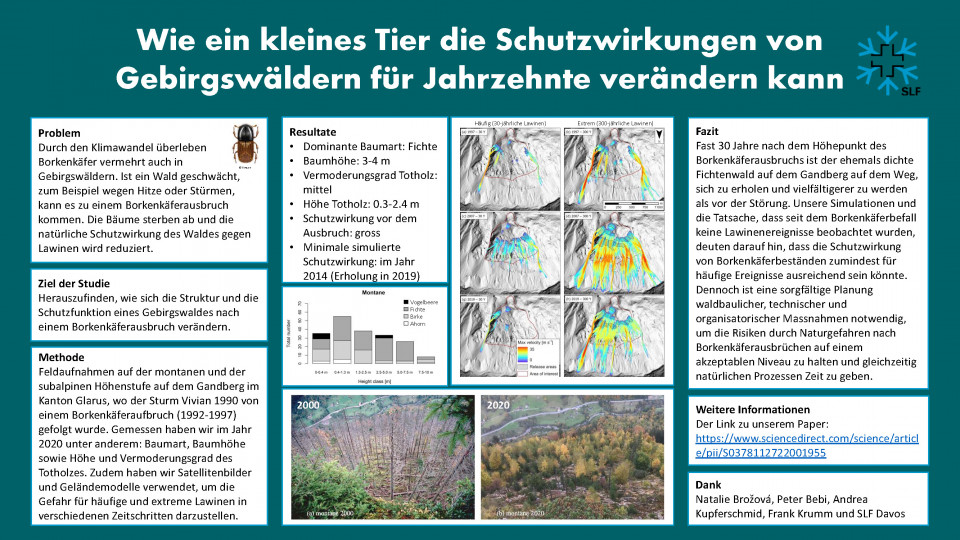The increase of large-scale bark beetle infestations in spruce dominated mountain forests has already had major effects on forest structure and ecosystem services in the past, and this trend is likely to intensify further with climate change. However, it is unclear how forests recover from bark beetle infestations over the long term, and how well different recovery stages fulfil the capacity of forests to protect infrastructures and human lives from natural hazards such as snow avalanches.
The aim of this study was to investigate how the structure and protective function of an uncleared bark beetle forest changed over time. The study area is located at the Gandberg in the Canton of Glarus in Switzerland, where the storm Vivian (1990) and subsequent bark beetle infestations (1992-1997, peaking in 1993) affected large parts of the forest. We re-surveyed the species composition and height of the tree regeneration, as well as the height and degree of decay of deadwood, in plots along transects that were already surveyed 20 years earlier. Eleven of our 24 sample plots were in the montane zone (1200-1450 m a.s.l.) and 13 in the subalpine zone (1450-1600 m a.s.l.). We used remote sensing data and avalanche simulations (RAMMS) to assess the protective effect of the forest against avalanches before the disturbances (1985) and afterwards (1997, 2007, 2014, and 2019) for frequent (30-year return period) and extreme (300-year return period) avalanche scenarios.
Post-disturbance regeneration led to a young forest that was again dominated by spruce, but still retained large amounts of deadwood, 27 years after the peak of the infestation. In 2020, the average height of the saplings (trees >1.3 m) reached 3 m in the subalpine zone and 4 m in the montane zone and crown cover was 10% and 30%, respectively. Although both elevational zones were dominated by spruce, the montane zone had a higher share of broadleaved species. Deadwood covered 20-25% of the forest floor. Most of the deadwood was in an early or intermediate decay stage and more seedlings were found on higher decay stages. More decomposed deadwood also had smaller heights than fresher deadwood. Less than 5% of the deadwood was taller than 10 m, which is a significant decrease compared to the value in 2001, where it was 50%. Remote sensing data and avalanche simulations showed that the forest prior to Vivian provided protection from both frequent and extreme avalanches. The storm Vivian caused new potential avalanche release areas within the forest, which were visible in the 1997 satellite image. During this time, the simulations showed a potential risk regarding extreme avalanche events. The protective capacity reached an overall minimum in 2007 because of the forest openings caused by the bark beetle infestation. The protective capacity partially recovered by 2014 and further increased by 2019, thanks to the establishment of new trees.
Our simulations and the fact that no avalanche events have been observed within the study area since the bark beetle infestation indicate that the protective effect of bark beetle stands may often be underestimated and that it may be sufficient, at least for frequent events. Furthermore, it is likely that subalpine forests take longer to recover their protective function due to harsher growing conditions. Forest structures with potentially insufficient provision of avalanche protection occur around 10-15 years after the infestation due to deadwood decomposition. Thanks to gradually establishing tree regeneration – first on soil and later on decomposing logs - the protective function increases again after this minimum. Nonetheless, careful planning of silvicultural, technical, and organizational measures is necessary to keep the risks from natural hazards following bark beetle infestations at an acceptable level, while allowing natural processes to develop towards more heterogenous and therefore more resilient forest structures.
